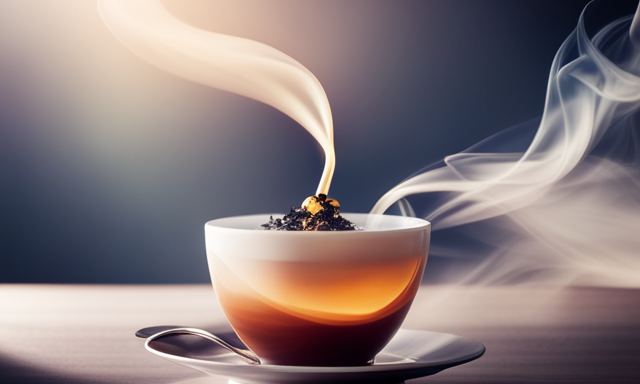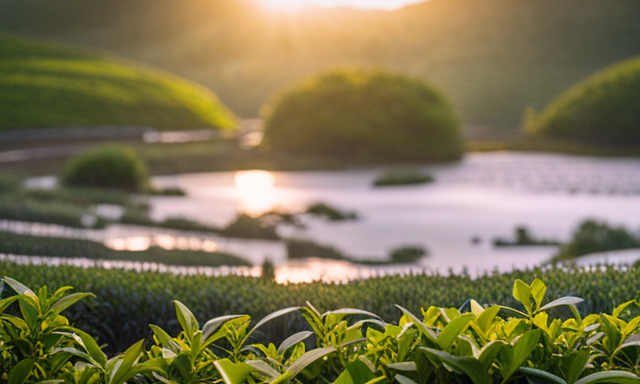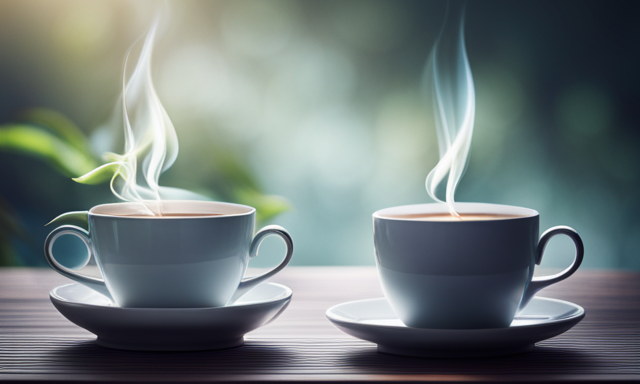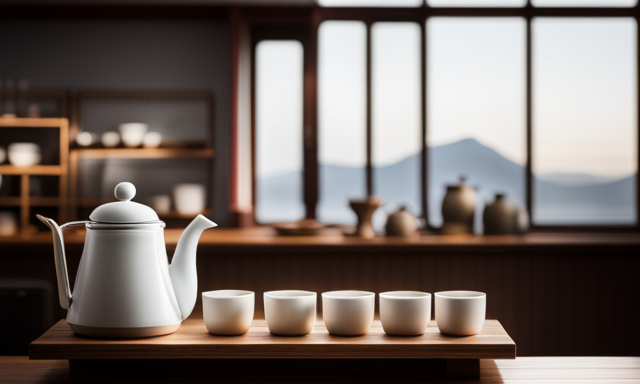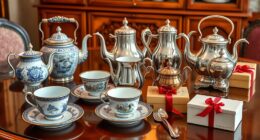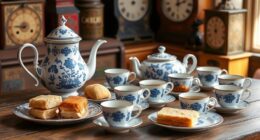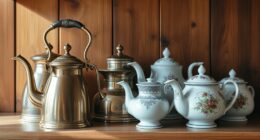As I take a sip of the warm, golden liquid, I am transported into a world of refined taste and exquisite aromas. Oolong tea, with its unique blend of oxidation levels and delicate processing, is a drink that captivates both the senses and the soul.
In this article, I will guide you through the subtle nuances and complexities of oolong tea, from its rich history and origins to the various types and varieties that exist.
We will explore the art of brewing oolong tea to perfection, uncover its distinct flavor profile, and delve into the enticing aromas that dance from the cup.
Additionally, we will discover the numerous health benefits that this tea has to offer and explore the art of pairing it with food.
Join me on this journey as we unlock the secrets of oolong tea and immerse ourselves in its timeless traditions and culture.
Key Takeaways
- Oolong tea has impressive antioxidant properties that neutralize harmful free radicals and protect cells from oxidative damage.
- Oolong tea reduces the risk of chronic diseases like heart disease and cancer, and its anti-inflammatory benefits alleviate inflammation in the body.
- Oolong tea enhances the taste and culinary experience when paired with fresh fruits, rich creamy desserts, spicy dishes, or savory snacks.
- Oolong tea ceremonies have cultural significance and involve the selection of the finest tea leaves, careful brewing process, and symbolism that represents harmony, respect, and gratitude.
History and Origins of Oolong Tea
Imagine yourself transported back in time to the misty mountains of China, where the rich history and origins of oolong tea unfold before your eyes.
Oolong tea has a fascinating history that spans centuries, tracing its roots back to the Tang Dynasty. It was during this time that the production of oolong tea began, and it quickly became a favorite among Chinese emperors and scholars.
The meticulous process of crafting oolong tea involves withering the leaves under the sun, then gently bruising and oxidizing them before they are finally fired to stop the oxidation process. This careful production method results in a tea that is known for its complex flavors and aromas.
As we delve into the types and varieties of oolong tea, we continue to unravel the enchanting story of this exquisite beverage.
Types and Varieties of Oolong Tea
Explore the world of Oolong tea and discover a wide array of delightful and aromatic varieties waiting to be savored. Oolong tea is known for its unique semi-oxidized processing method, which gives it a distinct flavor profile that falls between green and black tea.
There are several types of oolong tea, each with its own distinct characteristics. From the floral and fruity notes of the light oolongs to the rich and roasted flavors of the dark oolongs, there is a flavor to suit every palate. Some popular varieties include Tie Guan Yin, Da Hong Pao, and Oriental Beauty.
To fully appreciate the complex flavors of oolong tea, it is important to use the right brewing techniques. In the next section, we will explore the art of brewing oolong tea and how to bring out its true essence.
Brewing Techniques for Oolong Tea
Master the art of brewing oolong tea with these simple techniques that will bring out its true essence and leave you craving for more.
To brew oolong tea perfectly, you will need some essential brewing equipment. A teapot or gaiwan is ideal for steeping oolong tea, as it allows the leaves to unfurl and release their full flavor.
The water temperature is crucial, as oolong tea is delicate and requires a lower temperature compared to black tea. Generally, steeping oolong tea for 3-5 minutes at 190-205°F will yield the best results. However, the steeping times may vary depending on the specific oolong tea variety you are brewing.
Remember, oolong tea is a journey of taste and aroma, so experiment with different steeping times to find your perfect cup.
Transitioning into the subsequent section about the ‘flavor profile of oolong tea,’ understanding the brewing techniques is essential to unlocking the intricate flavors that await.
Flavor Profile of Oolong Tea
As you sip on this amber elixir, your taste buds will embark on a harmonious journey through the orchard, with notes of ripe peaches, floral hints, and a subtle nuttiness that dances on your palate. The flavor complexity of oolong tea is truly remarkable, offering a delicate balance between the freshness of green tea and the richness of black tea. To fully appreciate its nuances, it is crucial to brew oolong tea at the appropriate temperature. The brewing temperature for oolong tea typically ranges between 185°F and 205°F (85°C – 96°C), allowing the leaves to unfurl and release their full flavor potential. This precise brewing technique ensures that every sip reveals the intricate layers of taste that make oolong tea so captivating. Transitioning into the subsequent section about the aroma and fragrance of oolong tea, we delve into another sensory experience that complements its exquisite flavor.
Aroma and Fragrance of Oolong Tea
Immerse yourself in the captivating world of oolong tea as its enchanting aroma wafts through the air, inviting you to take a deep breath and savor the delicate fragrance that lingers long after each sip.
Aroma analysis and fragrance exploration are essential when describing the sensory experience of oolong tea. The aroma of oolong tea can vary widely depending on the specific variety and processing methods used. It can range from floral and fruity notes to woody and roasted undertones.
The fragrance of oolong tea is a result of the complex chemical compounds present in the leaves, which are released during brewing. These compounds interact with our olfactory receptors, creating a multi-layered sensory experience.
As we delve deeper into the world of oolong tea, let’s now explore the intriguing realm of its mouthfeel and texture, where each sip offers a symphony of sensations.
Mouthfeel and Texture of Oolong Tea
After savoring the delightful aroma and fragrance of oolong tea, the next aspect that captivates my senses is its unique mouthfeel and texture. Oolong tea offers a remarkable experience as it glides smoothly over my palate, leaving a velvety sensation that lingers with each sip. The mouthfeel is often described as rich and full-bodied, with a delightful balance of thickness and silkiness.
This tea’s texture is distinct, offering a pleasant interplay between the leaves’ natural oils and the brewing process, resulting in a truly satisfying sensation.
- The mouthfeel of oolong tea is velvety and smooth, providing a luxurious drinking experience.
- The texture of oolong tea is rich and full-bodied, with a perfect balance between thickness and silkiness.
- The interplay between the natural oils of the leaves and the brewing process creates a uniquely satisfying sensation.
As we explore the fascinating health benefits of oolong tea, let us delve into how this exceptional beverage contributes to our well-being.
Health Benefits of Oolong Tea
Oolong tea offers numerous health benefits, making it an excellent addition to any diet.
One key benefit is its ability to support weight management and boost metabolism, making it a popular choice for those looking to shed a few pounds.
Additionally, oolong tea is rich in antioxidants and has anti-inflammatory properties, which can help protect against chronic diseases and promote overall wellness.
Weight Management and Metabolism Boost
At first sip, this magical tea can help you shed pounds and rev up your metabolism like a turbocharged engine. Oolong tea is not only a delicious beverage, but it also offers numerous health benefits for weight management.
Here are three reasons why it is a game-changer:
-
Calorie burning effects: Oolong tea contains polyphenols, which activate thermogenesis in the body. This process increases the number of calories burned, helping you achieve your weight loss goals.
-
Appetite suppressant: The unique combination of caffeine and catechins in oolong tea can help control cravings and reduce hunger pangs. By suppressing your appetite, you are less likely to overeat and consume excess calories.
-
Metabolism booster: Oolong tea has been shown to increase metabolism and enhance fat oxidation. This means that your body can efficiently convert stored fat into energy, aiding in weight loss.
Transitioning into the next section about antioxidant and anti-inflammatory properties, oolong tea also offers a range of additional health benefits.
Antioxidant and Anti-Inflammatory Properties
With its abundant antioxidants and potent anti-inflammatory properties, this remarkable tea can provide a wealth of health benefits beyond just weight management and metabolism boost.
Oolong tea is known for its impressive antioxidant properties, which help neutralize harmful free radicals in the body. These antioxidants play a crucial role in protecting cells from oxidative damage and reducing the risk of chronic diseases such as heart disease and cancer.
Additionally, oolong tea’s anti-inflammatory benefits can help alleviate inflammation in the body, which is linked to various health conditions such as arthritis and inflammatory bowel disease.
By incorporating oolong tea into your daily routine, you can harness these powerful properties to support your overall well-being.
Moving on to pairing oolong tea with food, let’s explore the delightful combinations that enhance both taste and health benefits.
Pairing Oolong Tea with Food
Explore the intricate flavors of oolong tea by experimenting with different food combinations and discovering the perfect pairing to elevate your culinary experience. To fully appreciate the unique taste of oolong tea, here are four flavor combinations that complement its delicate notes:
-
Fresh fruits like peaches or apricots enhance the floral and fruity undertones of oolong tea.
-
Rich, creamy desserts such as crème brûlée or cheesecake provide a contrasting texture that balances the tea’s complexity.
-
Spicy dishes like Thai curry or Szechuan stir-fry create a harmonious blend with the tea’s subtle spiciness.
-
Savory snacks like roasted nuts or aged cheese bring out the earthy and nutty flavors in oolong tea.
By exploring these food pairings, you can fully appreciate the intricate flavors of oolong tea.
Transitioning into the next section, let’s delve into the rich traditions and culture surrounding this fascinating beverage.
Oolong Tea Traditions and Culture
Delving into the rich traditions and culture surrounding oolong tea is like uncovering a hidden treasure chest of centuries-old rituals and customs. Oolong tea ceremonies are an integral part of the cultural significance of oolong tea. These ceremonies are steeped in history and are a way to honor and appreciate the tea’s delicate flavors and aromas.
The ceremonies involve precise steps, such as the selection of the finest tea leaves, the use of specific teaware, and the careful brewing process to ensure the perfect infusion. Each aspect of the ceremony is steeped in symbolism, representing harmony, respect, and gratitude.
Oolong tea ceremonies provide a unique opportunity to connect with the tea’s origins and immerse oneself in the beauty of its traditions.
Transitioning into the subsequent section about tips for selecting and storing oolong tea, it is essential to understand the cultural significance before embarking on the journey of finding the perfect tea.
Tips for Selecting and Storing Oolong Tea
To ensure the best quality and flavor, you’ll want to consider these helpful tips when choosing and storing your oolong tea. When selecting oolong tea, it’s important to choose a reputable source that offers a variety of options. Look for teas that have been carefully harvested and processed, as this will greatly impact the taste and aroma. Additionally, consider the origin of the tea and the specific type of oolong you prefer, whether it’s a lighter, floral variety or a darker, more robust one. When it comes to storing oolong tea, keep it in an airtight container away from light, moisture, and strong odors. This will help preserve its delicate flavors and prevent it from absorbing unwanted aromas. Remember to store it at room temperature and consume it within a reasonable timeframe to fully enjoy its unique characteristics.
| Column 1 | Column 2 | Column 3 |
|---|---|---|
| Choose a reputable source | Consider origin and type | Store in airtight container |
| Look for carefully harvested and processed teas | Select lighter or darker varieties based on preference | Keep away from light, moisture, and strong odors |
| Ensure the tea is stored at room temperature | Consume within a reasonable timeframe |
Frequently Asked Questions
What is the difference between oolong tea and other types of tea?
Oolong tea stands out from other types of tea with its unique taste profile. Its rich, complex flavors range from floral to nutty, offering a delightful sensory experience. Additionally, oolong tea boasts numerous health benefits, including improved digestion and enhanced metabolism.
Can oolong tea be enjoyed iced or is it best served hot?
Iced oolong tea is a refreshing and delicious option. It can be enjoyed cold or hot, depending on personal preference. Aside from its great taste, oolong tea also offers numerous health benefits.
Are there any specific regions known for producing high-quality oolong tea?
In the picturesque regions of Fujian and Taiwan, the finest oolong tea is meticulously crafted. These specific areas are celebrated for their ideal climate and terroir, resulting in exquisite flavors and aromas. Additionally, oolong tea offers numerous health benefits, including improved digestion and metabolism.
Can oolong tea be re-steeped multiple times?
Yes, oolong tea can be re-steeped multiple times, allowing you to fully enjoy its flavors and reap the benefits of re steeping. Each infusion brings out different layers of complexity and richness.
Is oolong tea suitable for people with certain dietary restrictions, such as gluten-free or vegan diets?
Oolong tea is a versatile beverage that can accommodate various dietary restrictions. It offers gluten-free options for those avoiding gluten and vegan alternatives for individuals following a vegan diet.
Conclusion
In the realm of tea, oolong is a captivating and enigmatic character, with a rich history and diverse range of flavors. Its journey from ancient China to the modern tea scene is a testament to its enduring allure.
Like the delicate unfurling of a tea leaf, oolong tea unfurls a world of complex flavors and aromas, inviting us to explore its depths. With each sip, we are transported to the misty mountains and lush valleys where this tea originates.
Oolong tea is a true embodiment of balance and harmony, a symbol of the perfect blend of tradition and innovation. Its unique characteristics make it a versatile and delightful companion to a wide range of cuisines.
The health benefits of oolong tea are as abundant as its flavors, with its antioxidant properties and potential weight management benefits.
Whether enjoyed alone or in the company of friends, oolong tea is a true indulgence for the senses. So, let us raise our cups and toast to the enchanting world of oolong tea, where every sip tells a story and every moment is a celebration of the extraordinary.

